Making a wooden pipe
How to make a length of wood pipe using a drill press when a lathe is not available. These can be made any diameter suitable for the project and the length is only limited by the height of the drill press available.
An article by Ron Walters
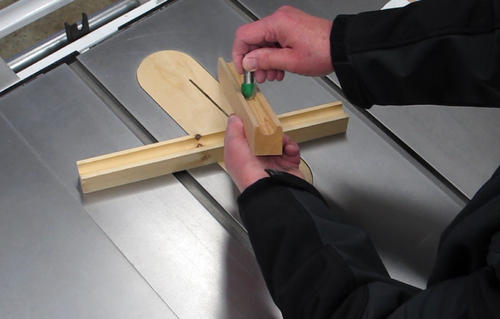 Cut two blanks to size, allowing 2 or 3 inches extra length. Use a core
box or bull nose router bit to form a half-circle trough centered the
length of the blank. Allow for a 1/4" flat either side of the trough for
glue.
Cut two blanks to size, allowing 2 or 3 inches extra length. Use a core
box or bull nose router bit to form a half-circle trough centered the
length of the blank. Allow for a 1/4" flat either side of the trough for
glue.
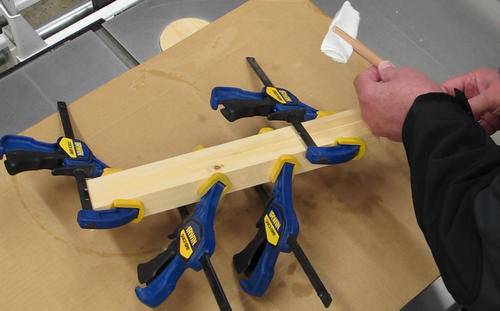 After the blanks have been glued and clamped together, use a
slotted dowel to run dry and wet paper towels inside to clean up any
glue squeeze out.
After the blanks have been glued and clamped together, use a
slotted dowel to run dry and wet paper towels inside to clean up any
glue squeeze out.
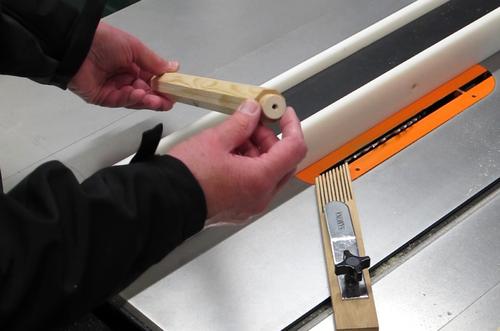 Cut the blank square and cut the corners off with the table saw
to bring the blank closer to being round
Cut the blank square and cut the corners off with the table saw
to bring the blank closer to being round
Install a center-drilled dowel in one end to allow installation of a wood screw or lag screw (with the head cut off). This will go into the drill press chuck.
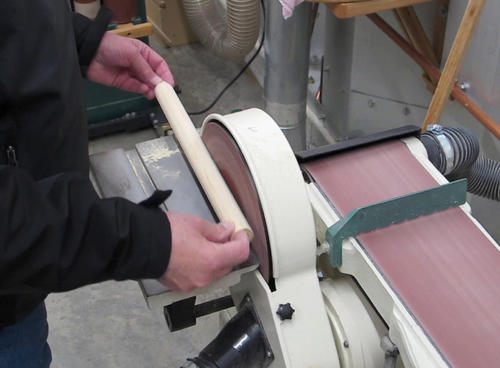 Use a disc/belt sander to remove excess material and round the blank.
Use a disc/belt sander to remove excess material and round the blank.
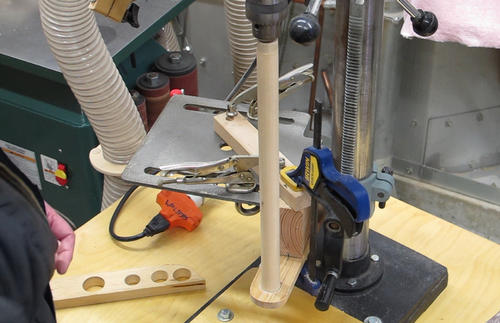 Make a sound, rigid jig to suit your drill press to serve as a
bearing block for the lower end of the pipe.
Make a sound, rigid jig to suit your drill press to serve as a
bearing block for the lower end of the pipe.
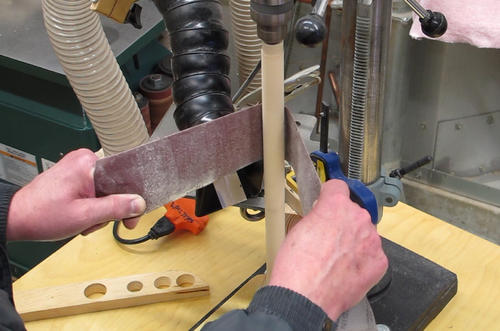 Run your drill press at a moderate speed while using a belt sander,
sandpaper and/or orbital sander to bring the pipe to an even diameter
the entire length.
Run your drill press at a moderate speed while using a belt sander,
sandpaper and/or orbital sander to bring the pipe to an even diameter
the entire length.
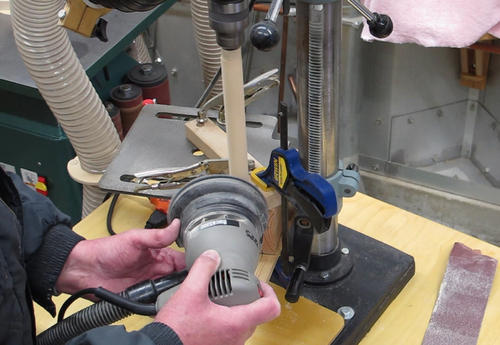 Be patient, this will take a while. Use of a Go /
No-Go gauge is handy for determining the places which are still too
large. Use caution when making the longer pipes. Support the center of
the pipe using another bearing block or your hand with a piece of
leather.
Be patient, this will take a while. Use of a Go /
No-Go gauge is handy for determining the places which are still too
large. Use caution when making the longer pipes. Support the center of
the pipe using another bearing block or your hand with a piece of
leather.
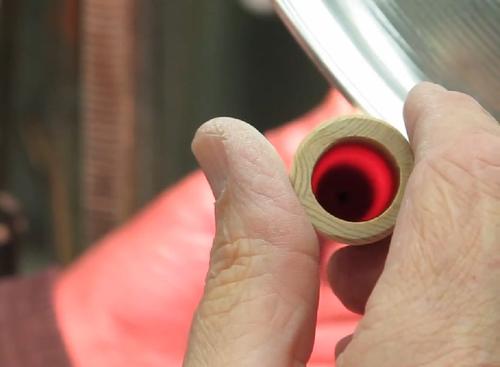 One way to inspect these is to occasionally hold them up to the light.
You can tell by the glow through the pipe if you are getting to a thin spot.
One way to inspect these is to occasionally hold them up to the light.
You can tell by the glow through the pipe if you are getting to a thin spot.
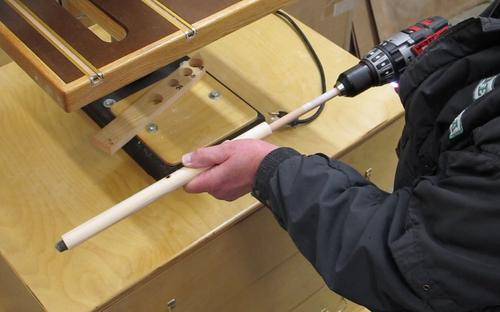 A piece of sandpaper in a slotted dowel can be used (with a
drill) to sand the inside surface of the pipe.
A piece of sandpaper in a slotted dowel can be used (with a
drill) to sand the inside surface of the pipe.
Another method: Wood Pipe On The Metal Lathe
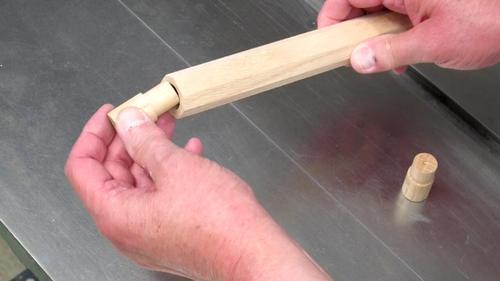 Here's another method for making a wooden pipe. I started by making
a blank the same way as earlier, then I turned a pair of wood dowels,
which were center drilled and turned to
fit inside the 3/4" hole (inside diameter) of the pipe blank. The wood
dowels were glued into the ends of the pipe blank.
Here's another method for making a wooden pipe. I started by making
a blank the same way as earlier, then I turned a pair of wood dowels,
which were center drilled and turned to
fit inside the 3/4" hole (inside diameter) of the pipe blank. The wood
dowels were glued into the ends of the pipe blank.
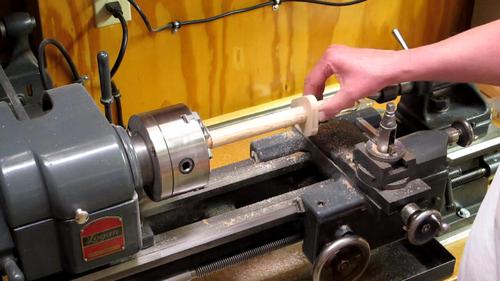 When installed in the
metal lathe, between the chuck and the live center, I would be assured
the outside diameter would be turned concentric to the inside diameter
of the pipe.
When installed in the
metal lathe, between the chuck and the live center, I would be assured
the outside diameter would be turned concentric to the inside diameter
of the pipe.
The Go/No-Go gauge enables a fast check of the entire length of pipe for consistent diameter.
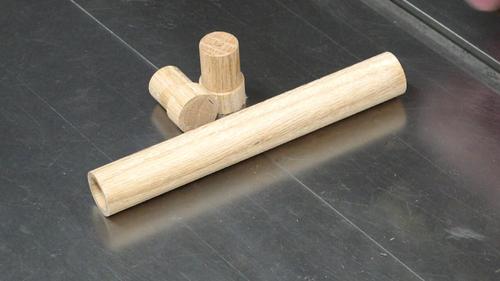 After the outside diameter is turned and sanded, the ends are cut off
and the usable section of wood pipe remains.
After the outside diameter is turned and sanded, the ends are cut off
and the usable section of wood pipe remains.
See also:
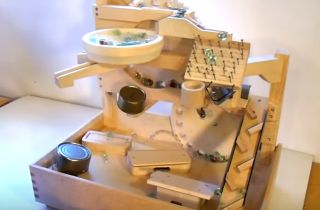
Marble machines |

Various clock wheel building experiments |
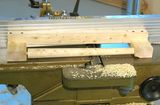
Making conic dowels and spindles |
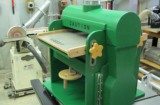
Homemade drum sander |
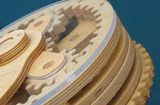
Planetary gear drive |